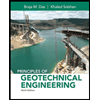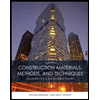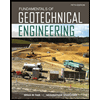Q1/ Choose the correct answer for the following: 1- Cantilever retaining walls is suitable for retaining backfill about a- 8m d-4m b- 12m c- 2m e- Any height 2-The shear key is provided to a- Avoid friction behind the wall d- All of the above b- Improve appearance e- None of the above c- Increase passive resistance types of retaining wall may b- Semi-gravity retaining walls d-Counterfort retaining walls be classified as follows: 3- The common a- Gravity retaining walls walls c- Cantilever retaining e- All the mentioned 4-Related to Stability of RW, Which of the following does not represent a potential failure mode for a retaining wall? a-Bearing capacity failure of the foundation soil. b- Wall cracking due to thermal expansion. c- Excessive settlement due to weak soil layer. d- Shear failure within the foundation soil adjacent to the wall. e-Sliding along the base due to insufficient friction. 5- If the desired factor of safety against sliding is not met, which strategy is NOT a suitable solution? a- Increase base slab width d- Reduce the backfill angle b- Use a key to the base slab e- All of the above. c- Use a deadman anchor 6- If the required factor of safety against sliding is not achieved, then the most practical choice is: a- Increasing the angle of soil backfill b- Increasing surcharge c- Increasing retaining wall dimensions d- Using a key to the base slab e- None of the above 7-The critical surface of sliding is a- The failure surface along which the minimum factor of safety is obtained b-The failure surface along which the larger factor of safety is obtained c-The failure surface along which the maximum factor of safety is obtained d- failure surface at a depth of about 1.5 times the width of base slab of the retaining e- None of the above.. 8- Design of gravity wall aims to a- resist appreciable tension d- all of the above b- safe against sliding e- none of the above e- safe against overturning 9-proportioning is a- some dimensions to allow recheck the section of wall for stability b- the height of the retaining wall c- the stem of the retaining wall d- the base of the retaining wall e- the depth of the retaining wall
Q1/ Choose the correct answer for the following: 1- Cantilever retaining walls is suitable for retaining backfill about a- 8m d-4m b- 12m c- 2m e- Any height 2-The shear key is provided to a- Avoid friction behind the wall d- All of the above b- Improve appearance e- None of the above c- Increase passive resistance types of retaining wall may b- Semi-gravity retaining walls d-Counterfort retaining walls be classified as follows: 3- The common a- Gravity retaining walls walls c- Cantilever retaining e- All the mentioned 4-Related to Stability of RW, Which of the following does not represent a potential failure mode for a retaining wall? a-Bearing capacity failure of the foundation soil. b- Wall cracking due to thermal expansion. c- Excessive settlement due to weak soil layer. d- Shear failure within the foundation soil adjacent to the wall. e-Sliding along the base due to insufficient friction. 5- If the desired factor of safety against sliding is not met, which strategy is NOT a suitable solution? a- Increase base slab width d- Reduce the backfill angle b- Use a key to the base slab e- All of the above. c- Use a deadman anchor 6- If the required factor of safety against sliding is not achieved, then the most practical choice is: a- Increasing the angle of soil backfill b- Increasing surcharge c- Increasing retaining wall dimensions d- Using a key to the base slab e- None of the above 7-The critical surface of sliding is a- The failure surface along which the minimum factor of safety is obtained b-The failure surface along which the larger factor of safety is obtained c-The failure surface along which the maximum factor of safety is obtained d- failure surface at a depth of about 1.5 times the width of base slab of the retaining e- None of the above.. 8- Design of gravity wall aims to a- resist appreciable tension d- all of the above b- safe against sliding e- none of the above e- safe against overturning 9-proportioning is a- some dimensions to allow recheck the section of wall for stability b- the height of the retaining wall c- the stem of the retaining wall d- the base of the retaining wall e- the depth of the retaining wall
Principles of Foundation Engineering (MindTap Course List)
9th Edition
ISBN:9781337705028
Author:Braja M. Das, Nagaratnam Sivakugan
Publisher:Braja M. Das, Nagaratnam Sivakugan
Chapter17: Retaining Walls
Section: Chapter Questions
Problem 17.7P
Related questions
Question

Transcribed Image Text:Q1/ Choose the correct answer for the following:
1- Cantilever retaining walls is suitable for retaining backfill about
a- 8m
d-4m
b- 12m
c- 2m
e- Any height
2-The shear key is provided to
a- Avoid friction behind the wall
d- All of the above
b- Improve appearance
e- None of the above
c- Increase passive resistance
types of retaining wall may
b- Semi-gravity retaining walls
d-Counterfort retaining walls
be
classified
as
follows:
3- The common
a- Gravity retaining walls
walls
c- Cantilever retaining
e- All the mentioned
4-Related to Stability of RW, Which of the following does not represent a potential
failure
mode
for
a
retaining
wall?
a-Bearing capacity failure of the foundation soil. b- Wall cracking due to thermal expansion.
c- Excessive settlement due to weak soil layer. d- Shear failure within the foundation soil
adjacent to the wall. e-Sliding along the base due to insufficient friction.
5- If the desired factor of safety against sliding is not met, which strategy is NOT a
suitable solution?
a- Increase base slab width
d- Reduce the backfill angle
b- Use a key to the base slab
e- All of the above.
c- Use a deadman anchor
6- If the required factor of safety against sliding is not achieved, then the most practical
choice is:
a- Increasing the angle of soil backfill b- Increasing surcharge c- Increasing retaining wall
dimensions d- Using a key to the base slab e- None of the above
7-The critical surface of sliding is
a- The failure surface along which the minimum factor of safety is obtained b-The failure
surface along which the larger factor of safety is obtained c-The failure surface along which
the maximum factor of safety is obtained d- failure surface at a depth of about 1.5 times the
width of base slab of the retaining
e- None of the above..
8- Design of gravity wall aims to
a- resist appreciable tension
d- all of the above
b- safe against sliding
e- none of the above
e- safe against overturning
9-proportioning is
a- some dimensions to allow recheck the section of wall for stability b- the height of the
retaining wall
c- the stem of the retaining wall d- the base of the retaining wall e- the
depth of the retaining wall
Expert Solution
This question has been solved!
Explore an expertly crafted, step-by-step solution for a thorough understanding of key concepts.
Step by step
Solved in 2 steps with 5 images

Recommended textbooks for you

Principles of Foundation Engineering (MindTap Cou…
Civil Engineering
ISBN:
9781337705028
Author:
Braja M. Das, Nagaratnam Sivakugan
Publisher:
Cengage Learning

Principles of Geotechnical Engineering (MindTap C…
Civil Engineering
ISBN:
9781305970939
Author:
Braja M. Das, Khaled Sobhan
Publisher:
Cengage Learning

Construction Materials, Methods and Techniques (M…
Civil Engineering
ISBN:
9781305086272
Author:
William P. Spence, Eva Kultermann
Publisher:
Cengage Learning

Principles of Foundation Engineering (MindTap Cou…
Civil Engineering
ISBN:
9781337705028
Author:
Braja M. Das, Nagaratnam Sivakugan
Publisher:
Cengage Learning

Principles of Geotechnical Engineering (MindTap C…
Civil Engineering
ISBN:
9781305970939
Author:
Braja M. Das, Khaled Sobhan
Publisher:
Cengage Learning

Construction Materials, Methods and Techniques (M…
Civil Engineering
ISBN:
9781305086272
Author:
William P. Spence, Eva Kultermann
Publisher:
Cengage Learning

Principles of Foundation Engineering (MindTap Cou…
Civil Engineering
ISBN:
9781305081550
Author:
Braja M. Das
Publisher:
Cengage Learning

Architectural Drafting and Design (MindTap Course…
Civil Engineering
ISBN:
9781285165738
Author:
Alan Jefferis, David A. Madsen, David P. Madsen
Publisher:
Cengage Learning

Fundamentals of Geotechnical Engineering (MindTap…
Civil Engineering
ISBN:
9781305635180
Author:
Braja M. Das, Nagaratnam Sivakugan
Publisher:
Cengage Learning